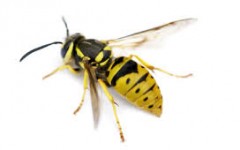About Yellow Jackets
 German yellow jackets are Ohio’s most common type of yellow jacket. During the winter months only mated queens will survive in the hibernated state. Around November the yellow jacket queen will begin searching for a suitable hibernation location such as a hollow log, a soil cavity, or even behind wall siding. They will remain in this location until around April when it begins to get warmer outside. Once leaving the hibernation location, the queen immediately begins search for a new nest site. Preferred sites include clusterred tree branches, behind wall siding, under porches, under eaves on buildings, and inside buildings underneath floors or in hollow walls. Old rodent holes in the ground are also made into nests for yellow jackets. Once the queen yellow jacket has found a suitable site and constructed a nest they will begin to lay eggs in each cell of the hive. Typically nests consist of around 50 cells. It will take about a month for the eggs to turn into adult workers. Throughout the summer the nest will continue to grow and at it’s peak, yellow jackets nest’s will contain 1,000 to 4,000 workers.
German yellow jackets are Ohio’s most common type of yellow jacket. During the winter months only mated queens will survive in the hibernated state. Around November the yellow jacket queen will begin searching for a suitable hibernation location such as a hollow log, a soil cavity, or even behind wall siding. They will remain in this location until around April when it begins to get warmer outside. Once leaving the hibernation location, the queen immediately begins search for a new nest site. Preferred sites include clusterred tree branches, behind wall siding, under porches, under eaves on buildings, and inside buildings underneath floors or in hollow walls. Old rodent holes in the ground are also made into nests for yellow jackets. Once the queen yellow jacket has found a suitable site and constructed a nest they will begin to lay eggs in each cell of the hive. Typically nests consist of around 50 cells. It will take about a month for the eggs to turn into adult workers. Throughout the summer the nest will continue to grow and at it’s peak, yellow jackets nest’s will contain 1,000 to 4,000 workers.
Yellow Jacket Prevention
To prevent your home from becoming a breeding ground for yellow jackets, some preventive measures should be taken. This includes:
- Walk your property regularly during the Spring months to check for hives. Pay special attention to the locations mentioned previously where yellow jackets like to make their home.
- Caulk any cracks or crevices around your home. Pay special attention around openings such as windows and doors.
- If a queen is spotted make sure to kill the queen and then remove the nest. If you remove the nest first the queen will get defensive and become aggressive.
Large nests can be very difficult to completely remove from a property without professional assistance. It can also be risky trying to remove a hive by oneself as a disturbance to the nest will provoke the yellow jackets to defend their home. A professional should be contacted in these situations to assess the infestation.

